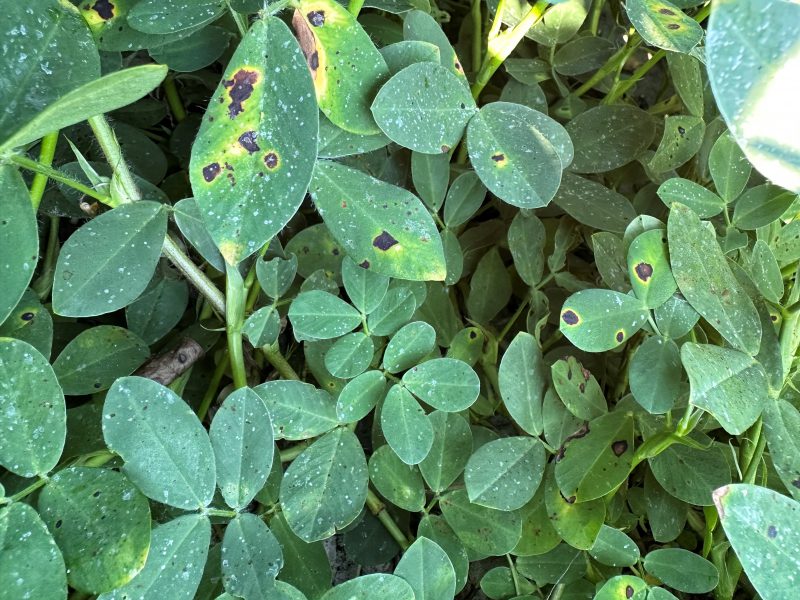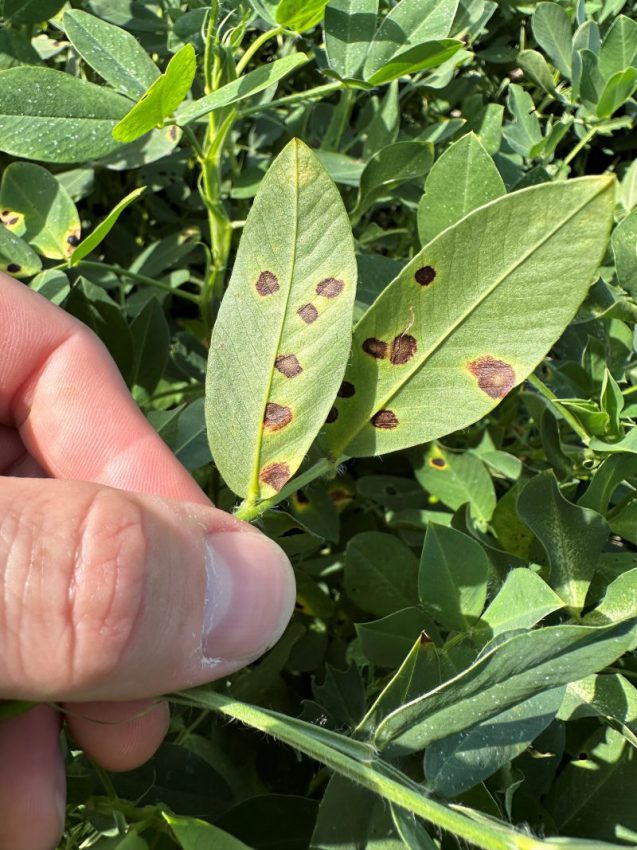With 30-40 days still to maturity in most area peanut fields, detection of Early Leaf Spot (ELS) last month in multiple counties set Panhandle peanut growers on their toes – with good reason. Finding ELS before we encounter the Late Leaf Spot (LLS) infections more typical of the Panhandle this month is very concerning and yet another thing for growers to worry about. Fueling these concerns are favorable weather conditions for disease development – extremely hot and very humid with intermittent rainfall. The final puzzle piece that makes growers’ lives difficult is the presence of abiotic (non-disease) leaf spotting that can be prevalent and muddy the waters when weighing an extra fungicide spray, if not accurately identified.
Because of the heightened awareness and favorable weather, I was called out to scout a Calhoun County field of ‘TifNV-High O/L’ peanuts this week following grower concerns regarding leaf spot. The field in question was planted around 100 days prior and had plenty of time left for a pathogen to cause serious damage. Closer inspection revealed near-black suspicious spots in the lower canopy, but many were very irregular, unlike the typically circular ELS, and didn’t possess sporulating structures you would associate with a fungal infection. Though an exact diagnosis is difficult with the many abiotic leaf conditions, these widespread, large, irregular spots appear to be “Irregular Leaf Spot” (ILS) or “Funky Leaf Spot”. First found back in the late 1990s, ILS looks very similar to early leaf spot but generally appears earlier and is much more irregular in shape. Most importantly, it is not a pathogen, doesn’t cause the devastating lower canopy defoliation of true Leaf Spot diseases, and does not affect yield. No need to add an additional spray for these abiotic leaf conditions, if fungicides effective against leaf spot are already present in the program.

Non-sporulating leaf spots in the interior canopy typical of an abiotic issue. Photo courtesy of Daniel Leonard, UF/IFAS
–
In the same field, there were also other spots that appeared more like LLS at first glance – more regular in shape and dark brown in color. Again though, after a closer look, they just didn’t fit the profile of a fungal leaf spot. These spots, while more regular in shape, only appeared in the upper canopy, did not possess the under-leaf sporulating fungal structures of LLS, and all had a lighter brown to gray center. The presence of leaf spotting in the upper canopy with lighter “buckskin” colored leaf centers is a tell-tale sign of chemical burn. In this case, the spots were likely from a shot of Provost Silver that had been applied a couple of weeks prior. Far from a bad thing, these abiotic lesions tell the grower that the fungicide he applied is there and doing its job!

Chemical burn on peanut leaves. Note the lighter colored centers and lack of sporulating structures. Photo courtesy of Daniel Leonard, UF/IFAS
–
While the race is on to protect peanuts from leaf spot pathogens now till harvest, it’s important to remember that not every leaf blemish is cause for concern. Timely and accurate ID of field issues like Leaf Spot, which local UF/IFAS Extension agents are willing and able to help with, is critical and can either save your crop by heading off an outbreak or, in this grower’s case, prevent an unnecessary spray and undue worry.
- Stay Ahead of Peanut Fungal Pathogens This Summer - August 8, 2025
- Panhandle Cotton Acres Are Down in 2025– Here’s the Reason - July 11, 2025
- It Snowed, But Has This Been a Historically Cold Winter? What the Data Says. - January 31, 2025
